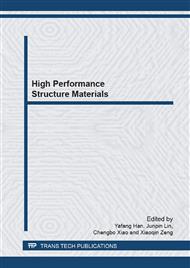p.238
p.245
p.251
p.257
p.264
p.270
p.276
p.282
p.289
Microstructure and Bonding Strength of AZ91/Al Composite Fabricated by Brazing and Hot-Rolling
Abstract:
In order to achieve the composite of the AZ91 magnesium alloy and pure aluminum sheet, Zn-Sn-Al solder as compound agent, electric arc plating was employed to spray the brazing solder on the surface of AZ91 and pure Al sheets. The sheets were then subjected to heat treatment at 420 for 10min before rolling lamination at a reduction of 10%. The as-rolled sheets were annealed at 390 for 4hours. The microstructure, phase constitution and bonding strength of the composite interface were tested and analyzed by using SEM and energy dispersive scope (EDS), x-ray diffraction and tensile test. Experimental results showed that, under the atmospheric environment, AZ91/Al composite can be successfully fabricated with Zn-Sn-Al solder by brazing and hot-rolling, and the shearing strength can reach 22.46MPa. After annealing for 4 hours, a diffusion layer composed mainly of Al and Zn elements was formed near Al matrix, and the intermetallic phases were MgZn2 and Mg2Sn which was the same to the phases at the interface of AZ91/Al composite without annealing, but the amount was relatively higher. The interfacial fracture of composite was mainly due to the existence of intermetallic phases.
Info:
Periodical:
Pages:
264-269
Citation:
Online since:
February 2013
Authors:
Keywords:
Price:
Сopyright:
© 2013 Trans Tech Publications Ltd. All Rights Reserved
Share:
Citation:


